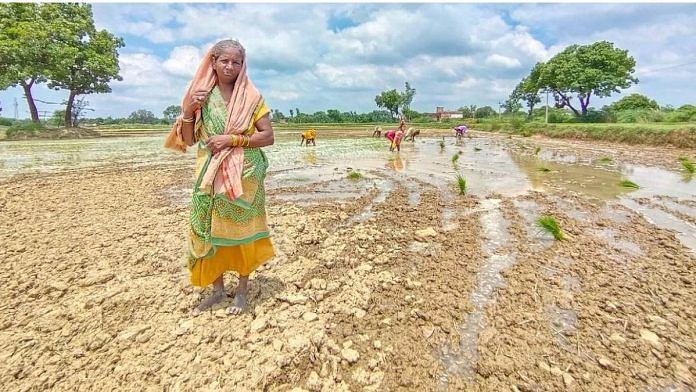India’s agriculture today faces three intertwined challenges: climate change, water scarcity, and declining soil health. Healthy soil plays a critical role in ensuring food security, water quality, biodiversity, and climate change mitigation. With its extraordinary capacity to form, store, transform, and recycle nutrients, soil produces 95 per cent of the world’s food. However, 33 per cent of global soils are already degraded, and this trend is accelerating.
To combat soil degradation and its threat to food security, the Food and Agriculture Organization of the United Nations (FAO) advocates for a comprehensive and coordinated approach to soil resource management. This call to action is encapsulated in the theme for World Soil Day 2024, observed on 5 December: “Caring for Soils: Measure, Monitor, Manage.”
Degrading soil quality threatens food security
An estimated 24 billion tons of fertile soil are lost to erosion each year. The loss of soil fertility results in low crop yields and crop failures, contributing to hunger, malnutrition, and poverty. Nutrient imbalance has been identified as one of the top ten threats to soil health.
Hidden hunger, caused by nutrient-poor diets, is also linked to nutrient-depleted soils, affecting over 2 billion people worldwide. About two-thirds of the global population is at risk of deficiency in one or more essential mineral elements.
While higher crop yields suggest that plants are getting nutrients from the healthy soil, global estimates show that the average nutritional value of major crops has declined since 1950, with some vitamins and minerals decreasing by 15 to 40 per cent.
To address the impacts of soil erosion and nutrient depletion, it is essential to generate accurate soil data and information. This will enable farmers and policymakers to make informed, evidence-based decisions that reflect the true state of soil health on the ground.
The need for better soil data
Soil data and information are pivotal for managing soil resources effectively, and sustainable soil management could lead up to 58 per cent more food.
Key initiatives by FAO, such as the establishment of the Global Soil Information System (GloSIS) and the Global Soil Laboratory Network (GLOSOLAN), aim to harmonise soil data collection and analysis worldwide. Through these platforms, FAO supports countries in generating reliable soil data, building national soil information systems, and adopting state-of-the-art technologies for soil analysis and mapping. This data is vital for reporting progress on several Sustainable Development Goals (SDGs), including those related to food security, clean water, climate action, and life on land.
Emerging technologies like sensors, digital soil mapping, and artificial intelligence (AI) are enhancing decision-making processes in soil management. AI-driven insights enable real-time soil monitoring, allowing farmers and policymakers to make informed decisions about resource allocation, fertilizer use, and water management.
Also Read: These are the Bengaluru startups bringing AI and farmers together
India’s commitment to soil health
The Government of India has recognised the importance of soil health for sustainable agriculture and food security.
India’s National Mission for Sustainable Agriculture (NMSA) focuses on promoting Integrated Nutrient Management (INM) through judicious use of chemical fertilisers, bio-fertilisers, and organic manures.
The Krishi Decision Support System, part of the Indian government’s Digital Agriculture Mission, includes ‘Soil Profile Mapping’ and offers farmer-centric digital services to provide timely and reliable information for the agriculture sector. This system will integrate remote sensing data on crops, soil, weather, and water resources into a comprehensive geospatial system. As part of the mission, detailed soil profile maps at a 1:10,000 scale are planned for approximately 142 million hectares of agricultural land, with 29 million hectares already mapped in the soil profile inventory.
FAO has been working closely with the Government of India to ensure that soil health remains a priority in agricultural policies. Under the Global Environment Facility (GEF)-funded projects, for example, FAO is working towards promoting agroecology and climate-resilient agrifood systems in the country. FAO continues to provide technical assistance and policy support to implement practices of crop diversification, use of biofertilisers, and sustainable management of natural resources and improved livelihoods. Initiatives undertaken by FAO across the states of Chhattisgarh, Haryana, Madhya Pradesh, Mizoram, Odisha, Punjab, Rajasthan and Uttarakhand aim at improving soil health.
In addition, FAO is advocating the use of organic manures, compost, and biofertilisers. These sources have the potential to enrich the soil with essential nutrients, support biodiversity and reduce the need for chemical inputs.
FAO calls for a unified approach to foster systems collaboration, leverage emerging technologies, undertake capacity-building trainings on soil data collection and monitoring, and make data findable, accessible, interoperable, and reusable. Governments, farmers, scientists, and international organisations must work together to ensure that soils remain healthy for future generations and food security for all.
Takayuki Hagiwara is the UN Food and Agriculture Organization Representative in India. Views are personal.






